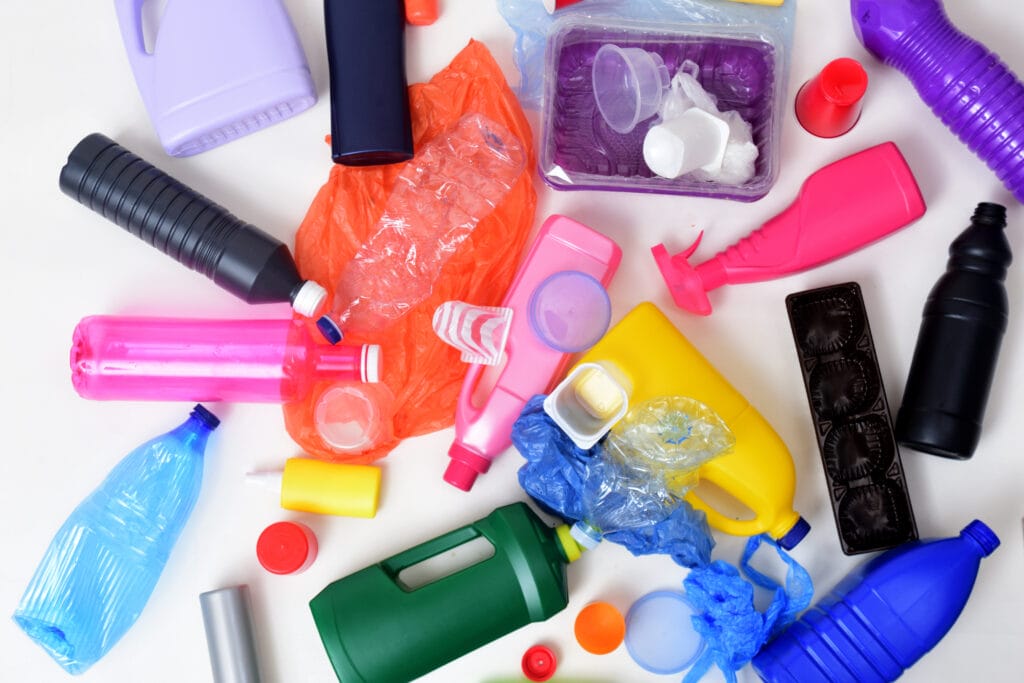
What Types of Plastics Can Be Recycled?
Here at CLYNK, we’re on a mission to recycle thousands upon thousands of containers every single day. But here’s something interesting: did you know that not all plastics are created equal? That’s right! There are different types of plastic, and each one affects how much of the recycled plastic from your bottles can be reused. In fact, there are seven types of plastic altogether, and you can find them in various products at your local grocery store or around your house. These plastics are sorted into categories based on their makeup and how they should be processed. Let’s dive into the world of plastic recycling and learn more about these materials!
- PET (polyethylene terephthalate): PET is the most common type of plastic we manage at CLYNK, as it is used to make water, soda, and juice containers. When you drop off a bag of containers at one of our bottle drop locations, this is the plastic material that will be taking up the most space. PET is versatile and very desirable in the plastic recycling business, as it has a long lifetime and can be reused to make new containers, carpets, furniture, and even fleece jackets. Nearly 25% of all PET bottles currently in circulation are made from reclaimed material, and by using CLYNK, you can help keep that number up.
- HDPE (high-density polyethylene): HDPE is used in milk jugs, chemical containers, and some toys. HDPE is a solid, general-purpose plastic that is quite easy to recycle and can be processed by curbside pickup programs. When this type is repurposed, it gets turned into a whole range of products, such as pens, detergent, and even furniture such as benches and picnic tables. The next time you head to your local park, try checking the benches and tables to see if they were made from repurposed HDPE.
- PVC (vinyl): PVC plastic is tougher than most plastics and is designed to withstand prolonged exposure to the elements, making it ideal for pipes and house siding. You can find it all over your house, in plastic food wrapping, wire jacketing, and kid’s toys. Unfortunately, PVC is made from several materials that become unsafe to consume as it ages. Because of this, less than 1% of all material is eligible for recycling. For this reason, we at CLYNK recommend not reusing old sandwich bags or other plastic containers. Try using a paper bag or a reusable solid plastic container for your food-packing needs.
- LDPE (low-density polyethylene): LDPE is a material that is found in abundance in the grocery store, taking the form of grocery bags, bread and produce bags, and tote bags. LDPE products can be reused for lengthy periods without breaking down, with thicker bags lasting years without losing their durability. However, this also makes it difficult to recycle LDPE and most curbside recycling programs do not process it. Any LDPE material that is reclaimed is typically turned into plastic lumber. If you have an outside deck or an extension that tends to get left in the rain, try using plastic treks to avoid wood rot or some of the other issues that can come from traditional timber.
- PP (polypropylene): Polypropylene is a tough, yet lightweight material that is used in condiment containers, drinking straws, and medicine bottles. This can make recycling PP plastic a tough job, as there are a lot of substances that can contaminate the material and make it unfit for repurposing. Even so, there are recycling companies that are determined not to let good materials go to waste. They reclaim as much usable PP plastic as they can and turn it into tools, such as brooms and rakes so that the material can make full use of its long lifespan.
- PS (polystyrene): Polystyrene, a well-known form of which is Styrofoam, is a material that is used extensively in disposable beverage cups and plates, as well as serving as egg cartons and take-out containers. The composition of polystyrene can make it difficult to recycle. Yet, there are many ways that PS plastic can be used even without recycling it. These include breaking it down to serve as drainage for potted plants, dissolving it with acetone to make glue, and, if you have a big enough container, using it as a makeshift cooler. When it is recycled it usually gets repurposed into foam packaging and insulation.
- Other (miscellaneous): Other plastics are blends of multiple plastic materials that prevent them from being listed as any single type of plastic. Essentially, these are plastics that have a little of everything and end up as something new. This can make it tough to know if they can be recycled, as part of them may be eligible and others are not. Because of this, a lot of material made from mixed plastics have to be thrown out. Those blends that can be recycled tend to be used in nylon products, and single-use food containers.
Try finding all of the plastics listed here inside your own home. You will be surprised just how many of your items have been made from reclaimed plastics.